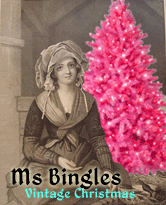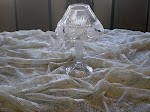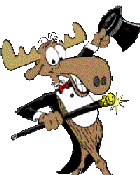1961 - "The Bullwinkle Show" premiered in prime time on NBC-TV. The show was originally on ABC in the afternoon as "Rocky and His Friends."
Show Summary
The Bullwinkle Show is a funny animated cartoon about a dimwitted moose (Bullwinkle) and his spunky flying squrriel friend (Rocky) getting in and out of adventures and foiling the plans of their archenemies (Boris and Natasha). Rocky is the smarter of the two. He likes to fly in the air and cook… More salami soufflé. Bullwinkle isn't the brightest star in the sky, he likes to hang out with his buddy Rocky. Boris is the short bad guy with the black suit and is the one with the "brains." Natasha is a tall skiny dark haired lady that assists in Boris's evil scheme. Both are sent to do evil plots by their boss, Fearless Leader.
First airing on ABC in 1959 with Rocky and Bullwinkle, the show was called "Rocky and his Friends". At that time, the show was in black and white. Later in 1961, the show moved to NBC with Bullwinkle's popularity, the show was renamed "The Bullwinkle Show". Then, the show began to run in color. The show would always air with a Bullwinkle segment, the "Fractured Fairy Tales" then "Mr. Know-it-All", "Peabody's Inprobabale History" Another Bullwinkle segment and finally "Bullwinkle's Corner".
"Hello poetry lovers" One of segments on the Bullwinkle Show...Bullwinkle's Corner Bullwinkle always tries to recite a famous poem, but stuff always happens: Boris wrecks the poem, Rocky doesn't do his part right, or it's just plain Bullwinkle's fault!
Rocky and Bullwinkle have been on TV for more than 40 years throughout various syndication. The show started in black and white called Rocky and His Friends, then went to color called The Bullwinkle Show. TV-G
Characters
Rocket J. "Rocky" Squirrel
One of the main stars of the show. Rocky is just an all-american flying squrriel who wears a blue aviator's helmets.
Bullwinkle J. Moose
The Main Moose. Bullwinkle is a dimwitted moose who always goes anywhere without little buddy (Rocky). He and Rocky live in a little town of Frostbite Falls, Minnesota.
Narrator
The guy who lets ya' know what's going on. When narrating, he uses awful puns or confused words that makes you wanna laugh or wanna make Rocky, Bullwinkle, and everyone else get sore.
Boris Badenov
A Pottsyvainaian spy who is always wanting to "kill moose and squirrel" with his parter, Natasha.
Natasha Fatale
Boris's partner in crime.
Fearless Leader
Boris and Natasha's boss and the one who comes up with the plans to defeat Rocky and Bullwinkle.
Mr. Big
A midget villain who wanted Bullwinkle's upsidasium. Then was sent to the moon, where he made metal munching mice to destroy American TV. He appears in "Upsidasium" and "Metal-Munching Mice".
Captain Peter Wrongway Peachfuzz
One of Rocky and Bullwinkle's friends. His fullname is Wrongway Peachfuzz and no wonder because he does everything the wrong way.
Gidney and Cloyd Moonman
The moonmen duo and Rocky and Bullwinkle's friends. Gidney is the one with the moustache and Cloyd is the one with the scrootch-gun. They appeared in "Jet Fuel Formula" and "Metal-Munching Mice".
Chaunzy and Edgar
Two old timers that are frequently seen in the show. Usually you see them saying "Well there's something you don't see everyday Chauntzy" "What's that Edgar?"
Uncle Dewlap
Bullwinkle's dead uncle who was twice removed, once for vagrancy, and the other for loitering.
Fairy
She introduced Fratured Fairy Tales and is always getting squished by the fairy tale book.
Edward Everett Horton
The guy who let's you know what's going on in Fractured Fairy Tales.
Mr. Peabody
A Genius dog who can go back in time with his "WAYBAC" machine.
SHERMAN
An orphan boy that Mr. Peabody adopted.
Other Minor Characters
Dudley Do-Right
A mixed-up Canadian mounty who is "always there to save the day". He appears in Upsidasium, Buried Treasure and The Last Angry Moose.
Nell Fenwick
Dudley's vision of lovelyness. Nell is the daughter of Ispector Fenwick. She appears in Upsidasium, Buried Treasure and The Last Angry Moose.
Inspector Nathaniel Fenwick
The Inspector of the R.C.M.P. (Royal Canadian Mounted Police) and Dudley's role model. He appears in Upsidasium, Buried Treasure and The Last Angry Moose.
Horse
Dudley's horse that Nell love. He appears in Upsidasium, Buried Treasure and The Last Angry Moose.
Snidley K. Whiplash
Dudley's archenemy and Nell's secret admirer. He appears in Upsidasium, Buried Treasure and The Last Angry Moose.
Aesop
An ancient Greek fableteller and alway's had a moral. He appears in Upsidasium, Metal-Munching Mice, Greenpernt Oogle, Rue Britannia, Buried Treasure, The Last Angry Moose, and Wailing Whale.
Junior
Aesops's son. He appears in Upsidasium, Metal-Munching Mice, Greenpernt Oogle, Rue Britannia, Buried Treasure, The Last Angry Moose, and Wailing Whale.
History
Rocky and Bullwinkle was originally to be part of the "Frostbite-Falls Revue." It was about a group of forest animals running a TV station. The group included Rocket J. Squirrel, Oski Bear, Canadian Moose (Bullwinkle), Sylvester Fox, Blackstone Crow, and Floral Fauna. The show was created by Jay Ward's former partner Alex Anderson, but it never sold.
Airing Format
From seasons 1-2 were formated as one Bullwinkle and Rocky cartoon, then a Fractured Fairy Tale (or Aesop and Son), Mr. Know-it-All, then Peabody (or Dudley Do-Right), another Bullwinkle and Rocky cartoon, and finally Bullwinkle's Corner. Season 1 and 2was in black and white, although, some syndicated stations play the colorized season 1 episodes, but NO ONE plays the black and white season 2 episodes.
From season 3-5 were formated as one Bullwinkle and Rocky cartoon, Mr. Know-it-All, then a Fractured Fairy Tale, another Bullwinkle and Rocky cartoon, and finally Bullwinkle's Corner, and one last B&R cartoon.
































































